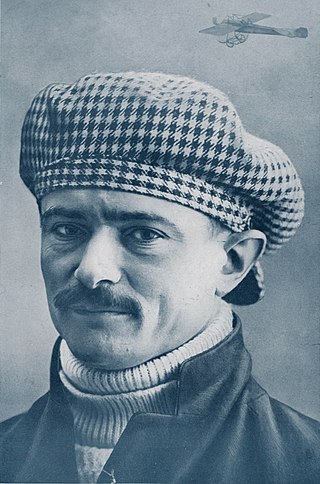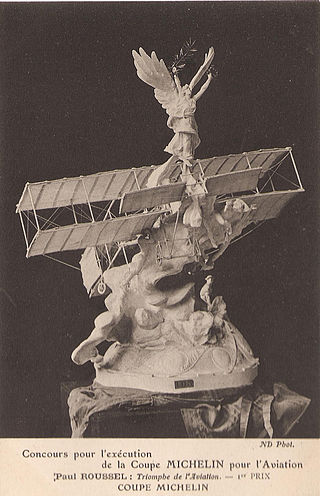
Brooklands was a 2.767-mile (4.453 km) motor racing circuit and aerodrome built near Weybridge in Surrey, England, United Kingdom. It opened in 1907 and was the world's first purpose-built 'banked' motor racing circuit as well as one of Britain's first airfields, which also became Britain's largest aircraft manufacturing centre by 1918, producing military aircraft such as the Wellington and civil airliners like the Viscount and VC-10.
This is a list of aviation-related events from 1911:

This is a list of aviation-related events from 1912:

Gustav Wilhelm Hamel was a pioneer British aviator. He was prominent in the early history of aviation in Britain, and in particular that of Hendon airfield, where Claude Graham-White was energetically developing and promoting flying.

Hendon Aerodrome was an aerodrome in London, England, that was an important centre for aviation from 1908 to 1968.
Trafford Park Aerodrome (Manchester) was the first purpose-built airfield in the Manchester area. Its large all-grass landing field was just south of the Manchester Ship Canal between Trafford Park Road, Moseley Road and Ashburton Road and occupied a large part of the former deer park of Trafford Hall. Today's Tenax Road runs north–south through the centre of the site of the old airfield, which was 0.7 miles northeast of today's Trafford Centre.

Cecil Howard Pixton was a British aeronautical engineer, test pilot and air racing pilot who was most famous for winning the 1914 Schneider Trophy seaplane race.

The 1910 London to Manchester air race took place between two aviators, each of whom attempted to win a heavier-than-air powered flight challenge between London and Manchester. The race had first been proposed by the Daily Mail newspaper in 1906. The £10,000 prize was won in April 1910 by Frenchman Louis Paulhan.

Théodore Clovis Edmond Lemartin, known as Léon Lemartin, was a pioneer aviator who set a world record on 3 February 1911 at Pau, France when he carried seven passengers in a Blériot XIII Aerobus. He then took eight, eleven and thirteen passengers aloft the following month. He is also known as the world's first professional test pilot.

Jean Louis Conneau, better known under the pseudonym André Beaumont, was a pioneer French aviator, Naval Lieutenant and Flying boat manufacturer.

Frederick Phillips Raynham (1893–1954) was a British pilot from the early days of aviation, gaining his aviator's certificate in 1911. He test-flew Avro, Martinsyde, Sopwith and Hawker aircraft before and after World War I. He later formed the Aircraft Survey Co. and the Indian Air Survey and Transport Co., flying in India and Burma.

The Cody Michelin Cup Biplane was an experimental aircraft designed and built in Britain during 1910 by Samuel Franklin Cody, a prominent showman and aviation pioneer. Cody had worked with the British Army on experiments with man-lifting kites and in October 1908 had successfully built and flown the British Army Aeroplane No 1, making the first officially verified powered flight in the United Kingdom. Cody broke the existing endurance record twice in the aircraft, the second flight, made on 31 December 1910, winning him the Michelin Cup for the longest-lasting flight made over a closed circuit in the United Kingdom before the end of the year.
The Circuit of Europe was an air race held in 1911. A prize of £8,000 was offered by Le Journal for the entire Circuit, with additional prizes for the individual stages. The stages of the race totalled 1,600 km (990 mi) were:

Jules Charles Toussaint Védrines was an early French aviator, notable for being the first pilot to fly at more than 100 mph and for winning the Gordon Bennett Trophy race in 1912.

The Cody Circuit of Britain biplane, also known as the Cody III, was the third powered aircraft built by Samuel Franklin Cody. It was flown by him in various competitions during 1911, including the Daily Mail Circuit of Britain competition in which Cody was the only British contestant to complete the course. On 29 October Cody set a new British endurance record in the aircraft, flying for five hours and fifteen minutes.

The Sopwith 1913 Circuit of Britain Biplane was a British floatplane built by Sopwith to take part in the 1913 Daily Mail Circuit of Britain Air race. The only entrant to start, it had to be withdrawn after a landing accident two-thirds of the way through the race.

The 1911 Paris to Madrid air race was a three-stage international flying competition, the first of several European air races of that summer. The winner was French aviator Jules Védrines, although his win, along with the rest of the race, were overshadowed by a notorious fatal crash at takeoff.
The Aerial Derby was an air race in the United Kingdom sponsored by the Daily Mail in which the competitors flew a circuit around London. It was first held in 1912, with subsequent races in 1913 and 1914. Suspended during the First World War, the event was revived in 1919 with a "Victory Aerial Derby". Further races were held in 1920, 1921,1922 and 1923. Although a race was scheduled for 1924 there were insufficient entries, and the event was cancelled and not held again.

Lieutenant-Colonel James Valentine was an early English aviator who died during the First World War, serving in the Royal Flying Corps.

The Michelin Cup refers to a number of competitions sponsored by the French tyre manufacturer Michelin for long distance flight made in aeroplanes.

















